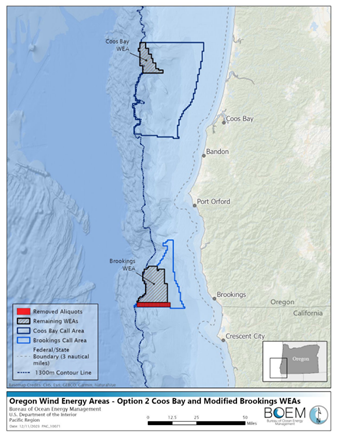On February 13, 2024, the Bureau of Ocean Energy Management (BOEM) designated two final Wind Energy Areas (WEAs) for the development of floating offshore wind energy projects off the southern coast of Oregon. This announcement represents a critical step in a years-long “collaborative deconfliction” process that is expected to conclude with an Oregon offshore wind lease sale in late 2024.
The two WEAs, which cover approximately 61,000 acres (Coos Bay WEA) and 134,000 acres (Brookings WEA) respectively, are approximately 25,000 acres smaller than the draft WEAs that BOEM released for public comment in August of last year. BOEM decided to remove from consideration a strip of ocean off the southern edge of the Brookings draft WEA in response to a request by the National Oceanic and Atmospheric Administration (NOAA) to preserve a corridor for fisheries surveys. See Figure 1. This is the first time BOEM has explicitly eliminated areas due to concerns over NOAA fisheries surveys, despite arguments from the offshore wind industry that NOAA’s survey methodologies can be modified to coexist with offshore wind development.



Figure 1
There are still two stages left in the offshore wind leasing process before BOEM conducts an auction to issue leases off Oregon: the proposed sale notice (PSN), where BOEM will take comments on the portions of the final WEAs it intends to lease, potential bidding credits, and proposed auction processes and lease provisions; and the final sale notice (FSN), where BOEM will announce the final leased areas. At either or both of these stages, BOEM may elect to make further reductions to the leasable area—although it is not obligated to do so.
Along with its final WEAs, BOEM also issued a notice of intent to prepare an environmental assessment (EA) under the National Environmental Policy Act (NEPA) that will analyze the anticipated environmental impacts of issuing offshore wind leases off Oregon. Consistent with BOEM’s usual practice, the EA will only analyze the impacts of site assessment and site characterization activities (i.e., meteorological buoys and surveys) on the eventual leases, deferring analysis of wind energy development until it receives site-specific project proposals.
Industry observers are watching closely to see how many companies will seek to qualify as bidders in an Oregon auction. The waters off the coast of Oregon are particularly well-suited to offshore wind energy production as they contain some of the strongest winds in the country. Additionally, the leases are in close proximity to the existing Humboldt leases off the coast of Northern California, creating offtake opportunities and potential economies of scale for transmission and supply chain development-- particularly since the Humboldt leases are expected to be developed using similar floating foundation technologies. A recent federal grant to develop offshore wind port infrastructure in Humboldt Bay also could boost commercial interest.
Despite all of these positives, the market for offshore wind energy in Oregon remains unsettled. Oregon law requires retail electricity providers to eliminate GHG emissions by 2040 and the Oregon Department of Energy has recognized the benefits of offshore wind in achieving that goal. However, there is not yet a clear path toward a market for offshore wind energy within the state. Additionally, local commercial fishermen and some coastal residents have been vocally opposed to offshore wind development, despite the fact that the final WEAs are sited the furthest from shore of all of the areas that BOEM has considered, and that BOEM has avoided the most heavily fished areas in the region. This distance from shore, as well as the average water depths that go with it, could also create technical challenges and increase the levelized cost of energy for projects off Oregon.
Based on BOEM’s typical timelines, we anticipate the Oregon PSN being issued in May or June of this year. Issuance of the PSN will open a 60-day comment period during which prospective bidders must submit their qualifications pursuant to BOEM’s regulations if they wish to participate in the lease sale.